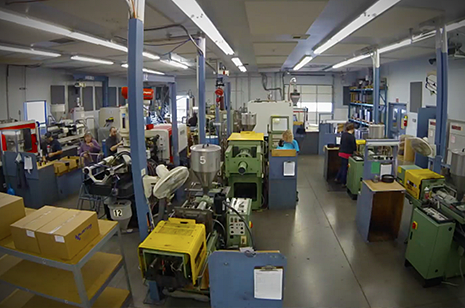- BY nwmcadmin
- POSTED IN Plastic Injection Molding
- WITH 3 COMMENTS
- PERMALINK
- STANDARD POST TYPE

Materials used in injection molding are plastics, specifically thermoplastics. There are hundreds of thermoplastics, but the most common thermoplastics used in injection molding are:
- Polypropylene
- Polyethylene
- Acrylonitrile Butadiene Styrene (ABS)
These three thermoplastic materials are used all the time. They are cost-effective, durable, and can tolerate the stresses of constant use. You likely use products made from these three materials often, if not every day. For example, ABS is the thermoplastic used to make your keyboard and parts of your phone.
What are Thermoplastics?
Thermoplastics are plastics that melt when heated and make plastic injection molding possible. Most of the plastic products used today are created using thermoplastics because of how diverse this material is. Some thermoplastics are very sturdy and rigid, while others are flexible and rubber-like. Some are clear and others are opaque. It is this diversity that makes thermoplastics such an appealing material for manufacturers.
Common Injection Molding Materials
Some other common materials used for injection molding include polycarbonate, nylon, acrylic, and polyoxymethylene. Each of these materials have their advantages and disadvantages, which is why, when determining which material to work with, you need to think of how the final product will be used. Will it need to be food-safe? Does it need to be heat tolerant? UV resistant? These are some of the things you need to consider before deciding which material to use.
Once you know which material to use, you will be able to decide which material is best for your project. Specifically, you will need to choose between an amorphous plastic or a semi-crystalline plastic. The main difference between these two families of plastics is how they react to heat.
Amorphous materials shrink or expand less when heated or cooled because they don’t have a sharp melting point, making the process more forgiving and gradual. Unlike amorphous plastics, semi-crystalline plastics have a much sharper melting point and are known to expand or contract a great deal more when exposed to changing temperature extremes.
Here is a list of the type of plastics used in injection molding, and which of the two families they fall under:
Amorphous plastics:
- Acrylonitrile Butadiene Styrene (ABS)
- Polystyrene (PS)
- Acrylic
- Polycarbonate
Semi-Crystalline plastics:
- Polypropylene (PP)
- Polyethylene (PE)
- Nylon (Polyamide)
- Polyoxymethylene (POM)
Ideal Materials for Injection Molding Products
The application of the product will determine the material used. If a product needs to be transparent yet still durable, like an automobile headlight, polycarbonate would be a good choice. What if your product is a container, like a milk jug? Then polyethylene is the type of material you’ll want to use. Polyethylene is often used for food packaging because it is food safe and won’t leach chemicals.
Here is a table of the most common thermoplastic materials used for injection molding with their unique features and most common applications.
| Type of Thermoplastic Material | Unique Features | Common Applications |
|---|---|---|
| ABS | durable, lightweight | electronics, keyboards, phone hardware, LEGO bricks, drainpipe systems, kitchen appliances |
| polyethylene | flexible, impact resistant, leech resistant, moisture resistant, recyclable | food packaging, milk jugs, toys |
| polypropylene | leech resistant, flexible | Tupperware, kiddie pools, toys, utensils, car batteries |
| polystyrene | warp, shrink and impact resistant | compact disc cases, packaging applications, household appliances |
| nylon / (POM) | heat-resistant, durable | high-ware parts, quick-release buckles, gears, hand cranks |
| acrylic | optical clarity, chemical resistant | tinted tubes, lab equipment, medical products, sports equipment, industrial components |
| polycarbonate | impact resistant, optical clarity, vulnerable to chemicals | automobile headlights, bulletproof glass, eyeglasses, greenhouses, DVDs, mobile phones |
Choosing the right material for your project will help to streamline the process, improve your product’s performance, and reduce costs.
If you want to learn what type of material is best for your next project contact us at Rex Plastics!



I’m making plastic pliers. mostly needle nose pliers. What material should I use, I don’t need strong heat or chemical resistance in the material used. They should not generate static charges, but they should be electrically non conductive.
The blog “Materials Used in Injection Molding” provides a comprehensive overview of the various materials suitable for injection molding processes. The author effectively discusses the properties and applications of common plastics, such as ABS, polypropylene, and polycarbonate, highlighting their strengths and limitations. This information is crucial for professionals in the industry who need to make informed decisions about material selection for specific applications. Thank you for sharing this valuable resource, and I look forward to more informative posts that delve deeper into material science and its impact on manufacturing!
Industrial manufacturing is a constantly evolving field, and staying up-to-date is essential to capture its progress effectively. This post provides some great insights! As an industrial video producer in the UK, I’m always looking for ways to improve my skillset and bring more to my clients. Thanks for sharing this article! – Luke https://lukesutton.co.uk and https://industreel.co.uk are my main businesses in this field.